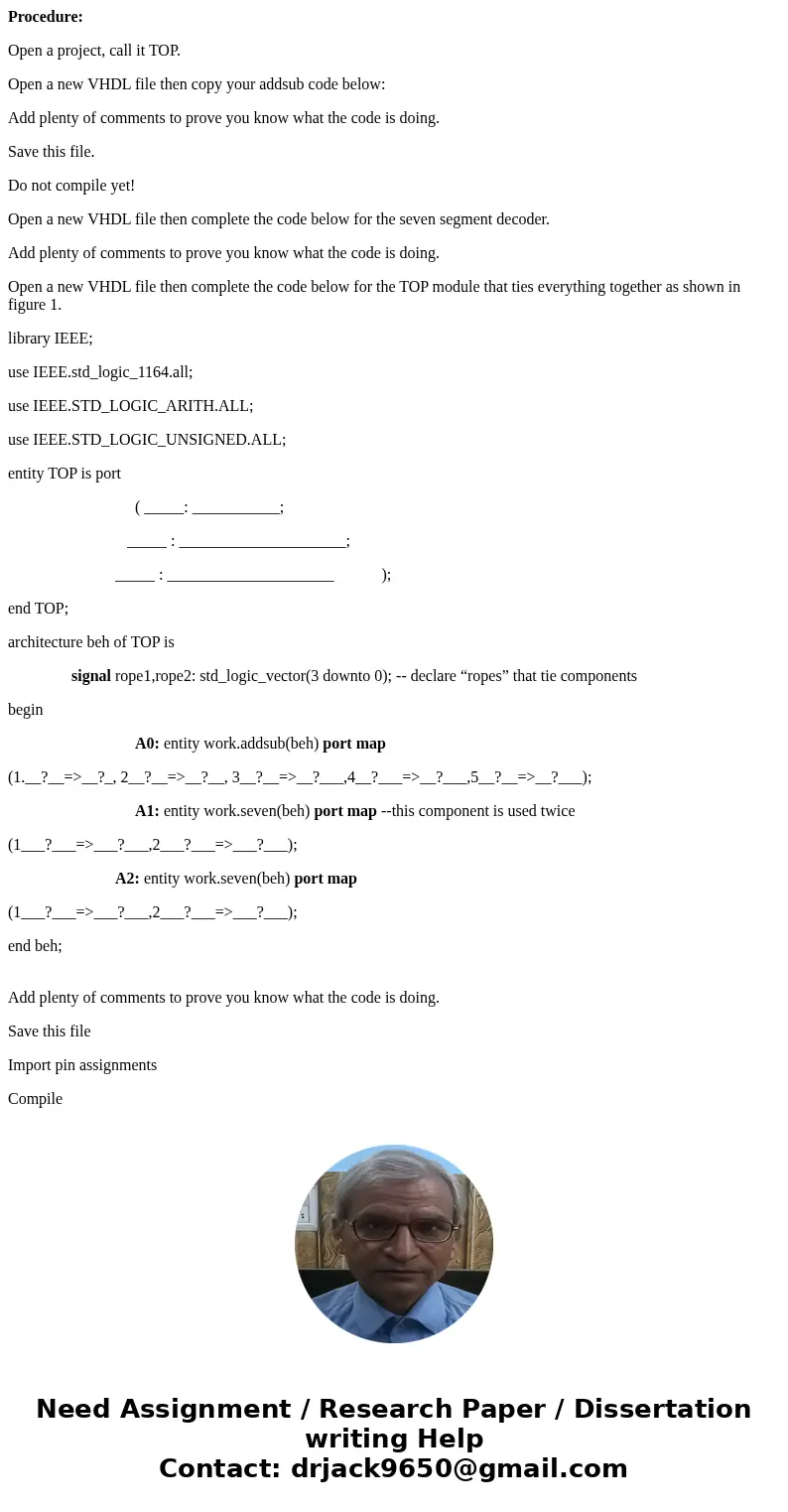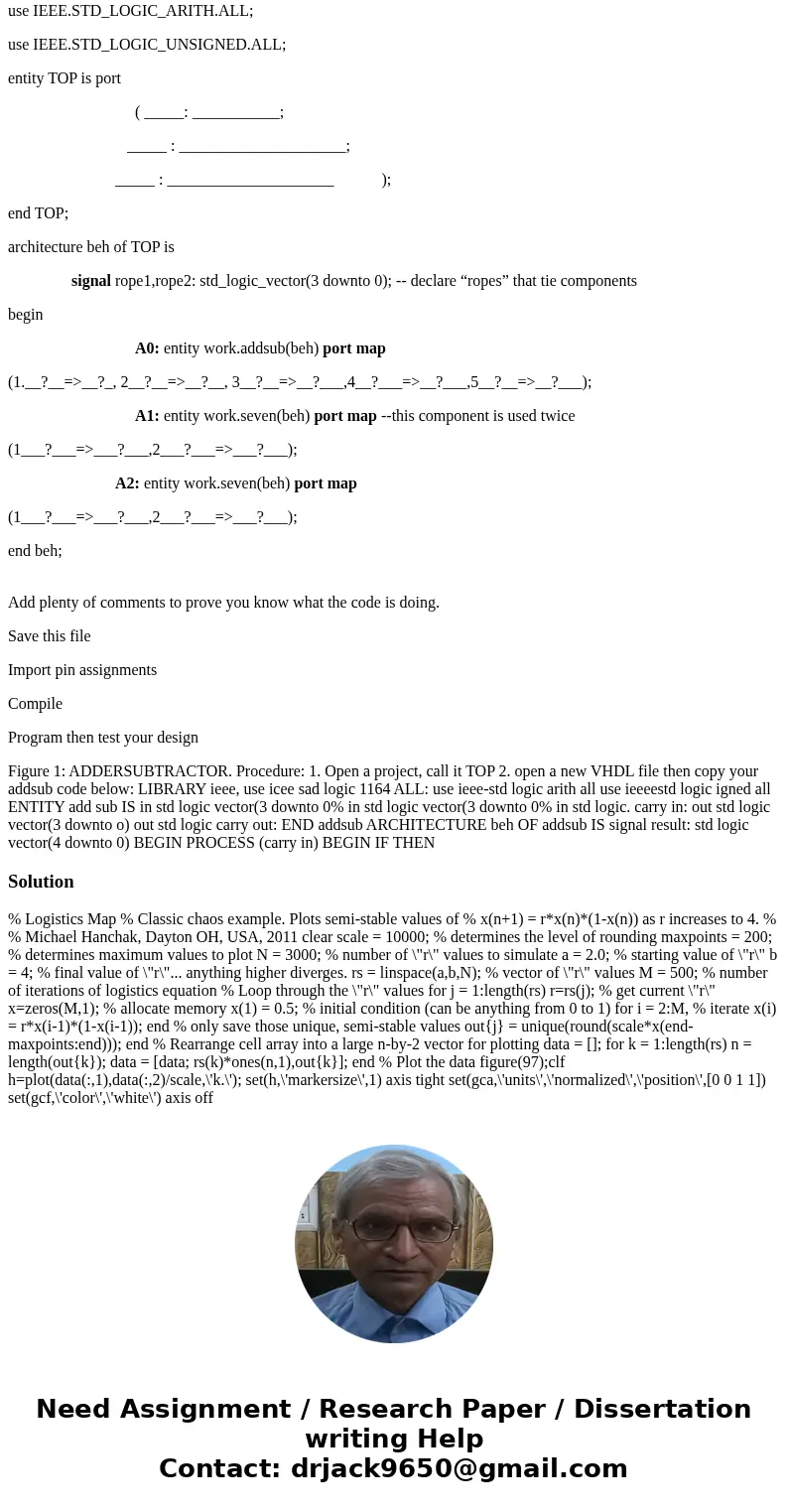Procedure Open a project call it TOP Open a new VHDL file th
Procedure:
Open a project, call it TOP.
Open a new VHDL file then copy your addsub code below:
Add plenty of comments to prove you know what the code is doing.
Save this file.
Do not compile yet!
Open a new VHDL file then complete the code below for the seven segment decoder.
Add plenty of comments to prove you know what the code is doing.
Open a new VHDL file then complete the code below for the TOP module that ties everything together as shown in figure 1.
library IEEE;
use IEEE.std_logic_1164.all;
use IEEE.STD_LOGIC_ARITH.ALL;
use IEEE.STD_LOGIC_UNSIGNED.ALL;
entity TOP is port
( _____: ___________;
_____ : _____________________;
_____ : _____________________ );
end TOP;
architecture beh of TOP is
signal rope1,rope2: std_logic_vector(3 downto 0); -- declare “ropes” that tie components
begin
A0: entity work.addsub(beh) port map
(1.__?__=>__?_, 2__?__=>__?__, 3__?__=>__?___,4__?___=>__?___,5__?__=>__?___);
A1: entity work.seven(beh) port map --this component is used twice
(1___?___=>___?___,2___?___=>___?___);
A2: entity work.seven(beh) port map
(1___?___=>___?___,2___?___=>___?___);
end beh;
Add plenty of comments to prove you know what the code is doing.
Save this file
Import pin assignments
Compile
Program then test your design
Figure 1: ADDERSUBTRACTOR. Procedure: 1. Open a project, call it TOP 2. open a new VHDL file then copy your addsub code below: LIBRARY ieee, use icee sad logic 1164 ALL: use ieee-std logic arith all use ieeeestd logic igned all ENTITY add sub IS in std logic vector(3 downto 0% in std logic vector(3 downto 0% in std logic. carry in: out std logic vector(3 downto o) out std logic carry out: END addsub ARCHITECTURE beh OF addsub IS signal result: std logic vector(4 downto 0) BEGIN PROCESS (carry in) BEGIN IF THENSolution
% Logistics Map % Classic chaos example. Plots semi-stable values of % x(n+1) = r*x(n)*(1-x(n)) as r increases to 4. % % Michael Hanchak, Dayton OH, USA, 2011 clear scale = 10000; % determines the level of rounding maxpoints = 200; % determines maximum values to plot N = 3000; % number of \"r\" values to simulate a = 2.0; % starting value of \"r\" b = 4; % final value of \"r\"... anything higher diverges. rs = linspace(a,b,N); % vector of \"r\" values M = 500; % number of iterations of logistics equation % Loop through the \"r\" values for j = 1:length(rs) r=rs(j); % get current \"r\" x=zeros(M,1); % allocate memory x(1) = 0.5; % initial condition (can be anything from 0 to 1) for i = 2:M, % iterate x(i) = r*x(i-1)*(1-x(i-1)); end % only save those unique, semi-stable values out{j} = unique(round(scale*x(end-maxpoints:end))); end % Rearrange cell array into a large n-by-2 vector for plotting data = []; for k = 1:length(rs) n = length(out{k}); data = [data; rs(k)*ones(n,1),out{k}]; end % Plot the data figure(97);clf h=plot(data(:,1),data(:,2)/scale,\'k.\'); set(h,\'markersize\',1) axis tight set(gca,\'units\',\'normalized\',\'position\',[0 0 1 1]) set(gcf,\'color\',\'white\') axis off

 Homework Sourse
Homework Sourse